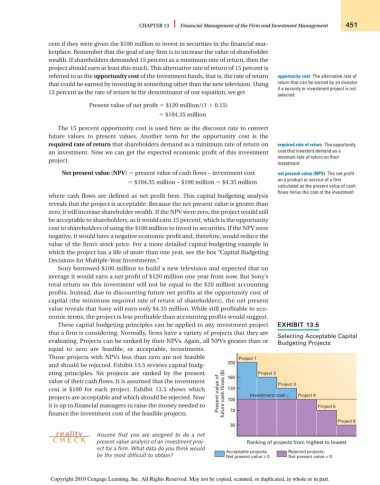Page 477 - Introduction to Business
P. 477
CHAPTER 13 Financial Management of the Firm and Investment Management 451
cent if they were given the $100 million to invest in securities in the financial mar-
ketplace. Remember that the goal of any firm is to increase the value of shareholder
wealth. If shareholders demanded 15 percent as a minimum rate of return, then the
project should earn at least this much. This alternative rate of return of 15 percent is
referred to as the opportunity cost of the investment funds, that is, the rate of return opportunity cost The alternative rate of
that could be earned by investing in something other than the new television. Using return that can be earned by an investor
if a security or investment project is not
15 percent as the rate of return in the denominator of our equation, we get selected
Present value of net profit $120 million/(1 0.15)
$104.35 million
The 15 percent opportunity cost is used here as the discount rate to convert
future values to present values. Another term for the opportunity cost is the
required rate of return that shareholders demand as a minimum rate of return on required rate of return The opportunity
an investment. Now we can get the expected economic profit of this investment cost that investors demand as a
minimum rate of return on their
project.
investment
Net present value (NPV) present value of cash flows – investment cost net present value (NPV) The net profit
$104.35 million – $100 million $4.35 million on a product or service of a firm
calculated as the present value of cash
flows minus the cost of the investment
where cash flows are defined as net profit here. This capital budgeting analysis
reveals that the project is acceptable. Because the net present value is greater than
zero, it will increase shareholder wealth. If the NPV were zero, the project would still
be acceptable to shareholders, as it would earn 15 percent, which is the opportunity
cost to shareholders of using the $100 million to invest in securities. If the NPV were
negative, it would have a negative economic profit and, therefore, would reduce the
value of the firm’s stock price. For a more detailed capital budgeting example in
which the project has a life of more than one year, see the box “Capital Budgeting
Decisions for Multiple-Year Investments.”
Sony borrowed $100 million to build a new television and expected that on
average it would earn a net profit of $120 million one year from now. But Sony’s
total return on this investment will not be equal to the $20 million accounting
profits. Instead, due to discounting future net profits at the opportunity cost of
capital (the minimum required rate of return of shareholders), the net present
value reveals that Sony will earn only $4.35 million. While still profitable in eco-
nomic terms, the project is less profitable than accounting profits would suggest.
These capital budgeting principles can be applied to any investment project EXHIBIT 13.5
that a firm is considering. Normally, firms have a variety of projects that they are
Selecting Acceptable Capital
evaluating. Projects can be ranked by their NPVs. Again, all NPVs greater than or
Budgeting Projects
equal to zero are feasible, or acceptable, investments.
Those projects with NPVs less than zero are not feasible Project 1
and should be rejected. Exhibit 13.5 reviews capital budg- 200
eting principles. Six projects are ranked by the present Project 2
value of their cash flows. It is assumed that the investment 160 Project 3
cost is $100 for each project. Exhibit 13.5 shows which 130
projects are acceptable and which should be rejected. Now Present value of future cash flows ($) 100 Investment cost Project 4
it is up to financial managers to raise the money needed to Project 5
finance the investment cost of the feasible projects. 70
Project 6
30
reality Assume that you are assigned to do a net
CH ECK present value analysis of an investment proj- Ranking of projects from highest to lowest
ect for a firm. What data do you think would
Acceptable projects: Rejected projects:
be the most difficult to obtain? Net present value ≥ 0 Net present value < 0
Copyright 2010 Cengage Learning, Inc. All Rights Reserved. May not be copied, scanned, or duplicated, in whole or in part.

